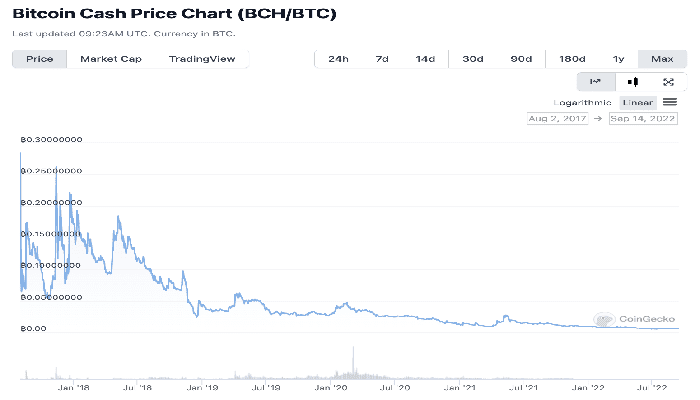Bitcoin is by far the dominant payment network with a native asset and continues to grow in market cap each year. The value in the network continues to grow as more miners come online to produce more hash rates, new users come online to hold and trade bitcoin, and new businesses come online to leverage the network in new and interesting ways.
That’s the power of the network effect; when you build on top of a solid foundation, you get access to the entire user base, you get the security of its decentralised node topology, to developers, to established and trusted code base and these effects compound on one another.
Smart and savvy business owners choose to build on bitcoin for these reasons and the possible upside attached to a network in its infancy, while others prefer to attack bitcoin by creating their own network through hard forks.
What Are Bitcoin Hard Forks?
In early 2009, a mysterious software developer, working under the pseudonym Satoshi Nakamoto, released a software program that created the bitcoin network, and to incentive, users to try it otu they were rewarded by securing the network with bitcoin, the first cryptocurrency. Since then, bitcoin has gone on to gain massive appeal across the globe and inspire hundreds of other digital currencies.
Over the last 13 years, we’ve seen plenty of copycats spring up along the way, building an entire altcoin industry with 20 000+ coins, all claiming they can improve on bitcoin, but have all failed to do that.
Many of these other cryptocurrencies employ technologies already inherent in Satoshi’s initial program and concept. Others take the bitcoin model and adapt or attempt to improve upon it, known as forks. A fork of bitcoin is when the primary code of bitcoin is used as the base of the project and tweaked instead of building a whole new code base. We’ve seen new blockchain code bases is the case with many of the EVM and smart contract chains, which strip out proof of work and add many complex security and incentive structures to compensate for it.
In the case of forking, the blockchain is divided into two distinct entities. There have been dozens of forks since bitcoin’s inception, but only some have continued to limp on, such as Bitcoin Cash and Bitcoin Satoshis Vision.
So if these networks are aiming to take market share away from bitcoin, how have they done thus far?
Bitcoin cash (BCH)
Bitcoin cash is arguably the most “popular” of the bitcoin forks emerging from the blocksize wars of 2017; like bitcoin, it has a hard cap and a steady issuance rate, and if you have the same monetary policy, you should be able to keep pace with the original asset or so people thought.
A thesis that has been prove false, as bitcoin cash continues to lose value in bitcoin terms, today 1 BCH will net you ₿0.00584884 or 584 884 Satoshi’s, a fraction of a real bitcoin (BTC).
Bitcoin Cash vs BTC – Source: CoinGecko
Bitcoin Satoshis Vision (BSV)
As with forked communities, they never feel the need to find consensus and prefer to fork to a point where they have control over the network. A short while after BCH launched, there was infighting and Bitcoin SV (BSV) is a full-node implementation and a fork of Bitcoin Cash (BCH). It attempts to restore the original Bitcoin protocol as set out by Satoshi Nakamoto in version 0.1 of Bitcoin, keeping it both stable and able to scale by again making trade-offs in security and decentralisation.
This new network also has Its native cryptocurrency BSV with a 21 million hard cap, which hasn’t done much for it; despite the scarcity of the coin, bitcoin satoshis continue to lose value in bitcoin terms; today, 1 BSV will net you ₿0.00256386 or 256 883864 Satoshi’s, a fraction of a real bitcoin (BTC).
Bitcoin SV vs BTC – Source: CoinGecko
Why do the forks fail?
Every fork makes a trade-off that is price into the market, and if your risk doesn’t seem worth it, such as increasing the block size on the base layer, market participants will show you their discontent by selling your token. Why would people want to hold on to an asset if they think the network is making a mistake?
This is the case with forks, while communities can break away and do their own thing, they can’t take the value with them.
Reallocation of value
When bitcoin forks, the native asset of the fork chain is often airdropped to participants of the old network too. If you had a bitcoin address during the time of the fork, you should get an equal or proportionate amount of the new asset on the other chain. People who receive these airdrops often see it as free money and would rather dump the “free coins” they get from this new network to acquire more bitcoin.
This creates massive selling pressure and drives down the price of the token.
Splitting the community
When a network forks, people choose sides; some nodes, miners and holders will head off with the new network while others remain on the old network. Since fewer people are willing to move towards the new network, you have far less liquidity to take with you; there are simply not enough buyers, not enough people who will run nodes or mine your coin and thus less demand for your coin.
One network to rule them all
Each fork that is create and fails proves that bitcoin made the right choices, and the market values security and decentralising the network at a massive premium. No matter how many resources these other networks have and how they’ve tried to improve their network and attack bitcoin, they simply cannot disrupt what seems to be an unstoppable force in the market for global money.
Forks prove that you can copy the code, the blockchain and the infrastructure, but you can’t fork the trust in the network’s history and security, the community, the conviction, the network effect or the chain.
As people try to fork bitcoin and fail, it serves as a case study and continues to prove that bitcoin is the king of digital payment networks and if you try to take a shot at the king, you best not miss.


































